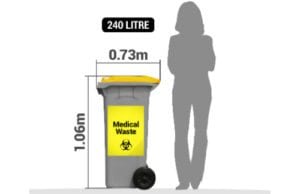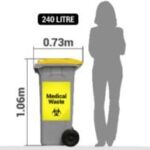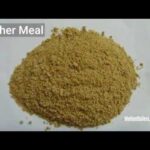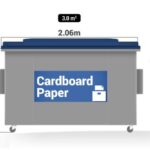Clinical Waste Disposal 2021 ⚕️: What To Know For Business Clinical Waste
Energy Disrupter
Clinical waste disposal: if you are a business that generates clinical waste or medical waste – you need to be aware that it has to be handled in a specific manner and can not be disposed of in general waste (your red bin) for common garbage. Clinical waste is hazardous for human health and needs to be disposed of in line with relevant legislation (described below).
You could be operating a doctors surgery, a dental practise or also a tattoo parlour etc. Please see detail as below as to what can qualify as safe clinical waste disposal from a waste management perspective in Australia.
>Download Now: Free PDF Business Owners Guide To Medical Waste Bin Services
Your requirements as regards handling clinical waste in healthcare and medical waste will be regulated by the EPA in your city or state. For example in Melbourne and Victoria the regulations are set by the Victoria EPA.
See a detailed document here showing your requirements under the Victoria EPA for handling clinical waste.
The criteria will vary slightly in some areas depending on the State or Territory in which you are located – but will be similar in most aspects.
What sort of businesses need to think about when handling clinical waste disposal?
You may be asking yourself what type of business generates clinical waste / medical waste from an EPA perspective and what your requirements are legally.
As per the Victoria EPA – clinical waste in healthcare includes the following – “Generators of clinical and related waste include (but are not restricted to):
• acupuncture clinics
• brothels
• collections of sharps and clinical and related waste from commercial buildings and workplaces (e.g. First aid waste)
• dental practitioners
• emergency services
• funeral parlours
• home healthcare
• long-term healthcare facilities
• needle exchange programs
• pathology laboratories
• schools
• universities
• veterinarians.
Hospitals and other larger-scale waste generators should refer to the Code of Practice for specific guidance on meeting waste management requirements”.
What materials are classified under clinical waste disposal. What is clinical waste, what is the definition of clinical waste
If you are a business owner – you may be uncertain as to what is the clinical waste meaning in your circumstances – i.e. an accurate definition of clinical waste and clinical waste categories. Knowing what constitutes handling clinical waste can be vitally important to ensure you comply with correct procedures.
[embedded content]
The exact clinical waste definition and clinical waste examples will vary slightly State by State in Australia but is broadly in line.
As per NSW EPA – the definition of what does clinical waste include is as per below – where they provide 3 or 4 examples:
Types of Clinical waste means any waste resulting from medical, nursing, dental, pharmaceutical, skin penetration or other related clinical activity, being waste that has the potential to cause injury, infection or offence, and includes waste containing any of the following (categories of clinical waste):
-
human tissue (other than hair, teeth and nails)
-
bulk body fluids or blood
-
visibly blood-stained body fluids, materials or equipment
-
laboratory specimens or cultures
As per the Victoria EPA – “Wastes arising from medical, nursing, dental, veterinary, laboratory, pharmaceutical, podiatry, tattooing, body piercing, brothels, emergency services, blood banks, mortuary practices and other similar practices, and wastes generated in healthcare facilities or other facilities during the investigation or treatment of patients or research projects“.
Types of clinical waste categories includes:
A. Sharps
B. a clinical specimen such as blood or tissue
C. A specimen of urine or faeces taken for laboratory testing includes specimens for analysis to ascertain disease status.
D. A laboratory culture
E. Human tissue
F. Tissue, carcasses or other waste arising from animals used for laboratory investigation or for medical or veterinary research other than psychological testing.
G. Human blood or body fluids other than urine or faeces.
H. Materials or equipment containing human blood or body fluids
I. Urine or faeces, or materials or equipment containing urine or faeces, where there is visible blood
J. Waste from patients known to have, or suspected of having a communicable disease
This definition as to what constitutes clinical waste is vitally important for correct procedures regarding what is clinical waste in a care home, what is clinical waste in hospitals etc.
Note – Waster offers rubber glove recycling services through Terracycle. However – this service is not suitable for gloves that have come into contact with bodily fluids. In that instance – the gloves should be disposed off in a clinical waste container.
What are the relevant clinical waste regulations / clinical waste legislation and guidelines for your business operations?
So now we know what clinical waste actually is and the definition – the next question to ask is – what does the clinical waste legislation and regulations actually tell us to do – and do we need a company clinical waste policy?
In each Australian State and Territory – whether Vic or Qld or NSW – you must follow the various clinical waste guidelines, regulations and legislation from your EPA – and make sure your business clinical waste policy is in line. The regulations cover everything from safe handling of infected or soiled linen and clinical waste to transporting clinical waste between sites.
Different jurisdictions overseas have different clinical waste classifications – such as clinical waste ewc codes in the United Kingdom.
Clinical waste regulations in Australia stem from the Clinical Waste Act 1990 – which you can see documentation on here. There is also an Australian and NZ standard – “AS NZS 3816 1998 management of clinical and related wastes” – see PDF version here.
Your requirements under clinical waste disposal regulations
“It is essential that clinical and related wastes are properly segregated, packaged, labelled, handled and transported to minimise risk to waste handlers and the community, such as needle stick injuries and transmission of infectious diseases. All sharps and other waste containers should meet the specific Australian Standards requirements. Clinical cytotoxic waste and related waste must be segregated and identified by colour coding and marked according to the following:
Colour code – clinical waste bins Australia: yellow
Wording: clinical waste displayed on at least 2 sides
Clinical waste sign : black biological hazard
Clinical waste symbol / logo: as above.
The clinical waste logo or clinical waste symbol should be clearly marked on the bags, sacks or bins.
The logo or symbol used is the “biohazard symbol as normally found on substances, materials, and containers that have biohazards. These are substances that pose a potential danger or risk to human life.”
“As an international symbol, it is used worldwide to indicate the presence of biohazard agent. It was developed in 1966 by Charles L. Baldwin of Dow Chemicals and Robert S. Runkle of the NIH.”
For staff education and to facilitate effective clinical waste segregation from non clinical waste – you should utilise clinical waste disposal posters in suitable locations.
Using a suitable and clear clinical waste poster – with the symbol as above – will facilitate correct treatment and safe handling of the waste.
“Where small quantities of clinical waste bin and related waste are being generated, effective storage can be achieved using 120/240 litre mobile garbage bin (wheelie bins)”.
Do you need a clinical waste management plan?
It is sensible for a business to have a documented clinical waste management plan or policy that is stored – i.e. whether as pdf, ppt etc. This should document your procedures as to how should clinical waste be managed, segregated management of clinical and related wastes from general waste etc.
This clinical waste management plan should be maintained and updated as appropriate.
Clinical waste bins Australia – sizes and options
The bins or clinical waste containers should be clearly colour coded as per the clinical waste bin size below. The bin in the image is a clinical waste 240 litre wheelie bins. We can also provide the collection service in 120 litre bins or 20 litre medical waste pails.
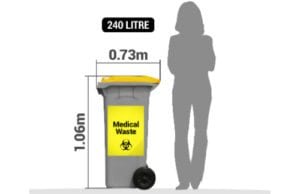



Clinical waste bin bags – yellow or orange bin bags?
In Australia – plastic clinical waste bin bags – or any clinical waste disposal bags (also called clinical waste sacks) should be coloured yellow as per the bin colouring above. The colour of clinical waste bags in all States and Territories in Australia is yellow.
Businesses can use small clinical waste bags / clinical waste sacks – i.e. clinical waste plastic bags to line the bins or for easy transport inside your location.
Note – the colour for clinical waste bin liners can also be orange – see document from SA EPA here.
Where does clinical waste go – i.e. how should clinical waste be disposed off?
Once the clinical waste has been collected in a bin, bag, sack or pail as above – you may be asking what is the final clinical waste treatment – i.e. what happens to clinical waste.
As the contents can be hazardous – the clinical waste collected will be treated either through incineration or through autoclave. The clinical waste incineration process – or autoclave process will see any bacterial components killed by the heat.
Whether the contents will go through a clinical waste incineration process or autoclave will depend on the location. You can see more on an autoclave here.
How to choose clinical waste disposal companies for your business
As a business – you have enough to worry about and need peace of mind that your clinical waste contractors are competent and professional.
Choosing qualified clinical waste collection companies will save you a lot of hassle later on. Most councils will not provide clinical waste services for business – so you will require clinical waste solutions from a commercial provider.
How Waster can help you with clinical waste disposal
Waster offers low cost, reliable and fully accredited and licensed medical waste collection services in both plastic clinical waste bins – 120 litre and 240 litre size clinical waste containers.
The service will involve provision of bins / containers and collection on a regular schedule. The medical waste will be taken for safe disposal – i.e. either autoclave or incineration depending on the location.
Waster provides services nationwide – including clinical waste disposal QLD, clinical waste disposal NSW and regional services such as in Newcastle, Ballarat etc.
Waster has recently been covered in the Australian press: Uber of Waste. You can check prices and book your required service by pushing the blue button below:
See our blog on medical waste disposal Sydney.
Conclusion:
Correct and safe disposal of hazardous clinical waste and treatment of your waste streams and of course medical waste bins is a business responsibility.
Organising correct and reliable and safe management of healthcare waste and hazardous wastes can be very cost effective and will ensure you prevent any issues down the line with compliance and health and safety. You can thus minimise waste disposal costs and provide a safe work environment for all.
Check out how a small office version of an autoclave works – industrial autoclaves are much larger!
[embedded content]



